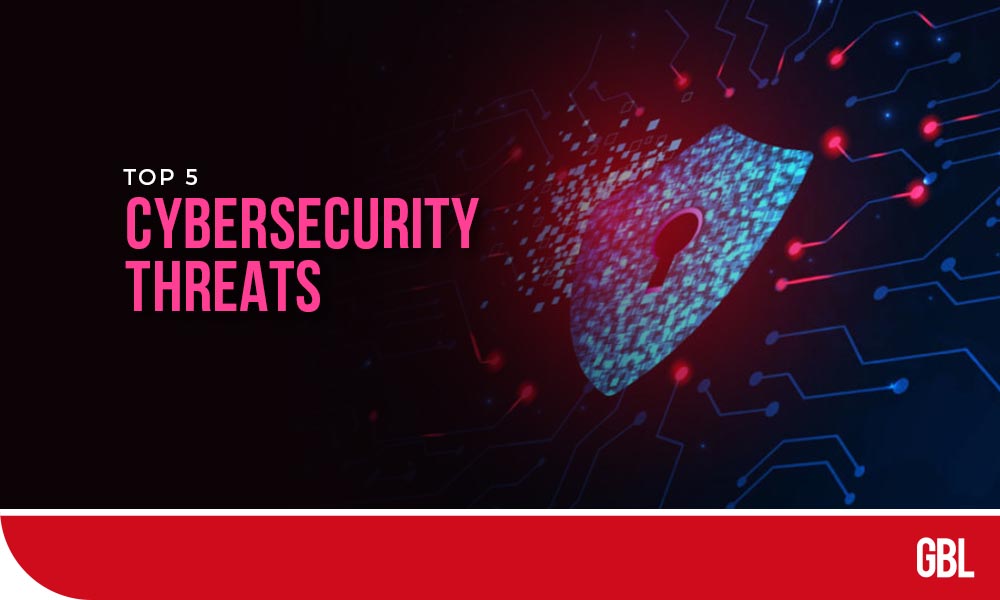As technology advances, so do the threats it poses to cybersecurity. The more we rely on technology, the more vulnerable we become to cyberattacks.
The prevalence of cybercrime is a pressing concern that continues to evolve in an ever-growing landscape of cyber threats. As organizations expand, so do their risks, particularly with their dependence on cloud-based systems, a globally distributed workforce, and the ever-increasing sophistication of social engineering tactics used by attackers.
Security professionals are faced with the challenge of addressing these issues and the responsibility of providing educational training and implementing cybersecurity awareness programs. We will discuss the top 5 cybersecurity threats individuals and organizations face today.
1) Phishing Attacks
Phishing attacks are a type of social engineering attack and a widespread cybercrime. These are the attempts to trick individuals into divulging sensitive information, such as login credentials or financial information. This is typically done through an email that appears to be from a legitimate source, such as a bank or other financial institution. These emails often contain a link that directs the recipient to a fake website that looks like the real thing but is designed to steal their information.
Attackers manipulate end-users using emotional tactics, such as fear and urgency, to exploit their vulnerability. Examples of these attacks include soliciting donations through fake websites or posing as legitimate entities to obtain login credentials for banks or streaming services. According to a recent report on email threats, phishing attacks increased by 48% from January to June 2022.
Phishing attacks can also take the form of phone calls or text messages and are becoming increasingly sophisticated. Some attacks may even use information gathered from social media to make the message seem more convincing.
As remote work continues to be a common practice, cybercriminals constantly refine their phishing attack strategies to deceive users. Today’s most prevalent tactics include fake shipping updates, healthcare appointment reminders, and impersonating bosses or colleagues to trick users into providing personal or financial information.
How to prevent phishing attacks?
To prevent phishing attacks, individuals should always verify the source of any messages or requests for information. This can be done by contacting the organization directly or by checking the URL of any links in the message. It is crucial to provide cybersecurity education to users.
2) Ransomware Attacks
Ransomware attacks have become increasingly common in recent years and involve an attacker encrypting an individual or organization’s data and demanding payment in exchange for the decryption key. These attacks can devastate businesses, resulting in the loss of sensitive data and the disruption of operations.
The acceleration of digital transformation has coincided with the development of ransomware technology and methods. With the shift to cloud computing, cybercriminals now have a global reach and have taken advantage of vulnerable organizations with weak security configurations.
How to prevent ransomware attacks?
Organizations of all sizes should conduct continuous testing and monitoring while implementing insights from ethical hackers to prevent ransomware attacks and strengthen IT and security infrastructure. Companies should have a comprehensive backup and disaster recovery plan in place. This will allow them to restore their data without paying the ransom. It is also important to keep software and security systems up to date to minimize the risk of a successful attack.
3) Insider Threats
Insider threats are a type of cybersecurity threats that comes from within an organization. This can include employees, contractors, or others with sensitive data or systems access. Insider threats can be intentional, such as an employee stealing data for personal gain, or unintentional, such as an employee accidentally disclosing sensitive information.
How to prevent insider threats?
To protect against insider threats, organizations should have strong access controls to limit the amount of data employees can access. They should also provide regular training to employees on identifying and reporting suspicious activity.
4) Internet of Things (IoT) Attacks
The Internet of Things (IoT) refers to the network of devices that are connected to the internet, such as smart home devices, medical devices, and industrial control systems. These devices are often not designed with security in mind, making them vulnerable to cyberattacks.
The Internet of Things (IoT) creates a new avenue for cybercriminals to access private information through connectivity and data exchange. IoT architecture is integrated into our personal lives, encompassing everything from household appliances to industrial and manufacturing tools.
The European Union (EU) is taking a proactive stance on IoT cybersecurity by proposing stringent regulations to be implemented by 2024. This has left overseas IoT product companies scrambling to comply with the new requirements. Similarly, it is only a matter of time before the United States passes similar mandates for IoT organizations to enhance their cybersecurity measures, following in the footsteps of the General Data Protection Regulation (GDPR) and the California Consumer Privacy Act (CCPA).
How to prevent IoT attacks?
To protect against IoT attacks, individuals and organizations should ensure that any IoT devices they use are secure and up to date. They should also segment their networks to minimize the risk of an attack spreading to other systems.
5) Remote Working Risks
Remote working has become the norm for many organizations, and while it offers flexibility and convenience, it also poses significant cybersecurity threats. Remote workers use personal devices and networks, which may not have the same level of security as company-owned equipment, making them vulnerable to cyberattacks.
One of the most significant risks of remote working is the increased potential for phishing attacks. Cybercriminals exploit the uncertainty and stress caused by the pandemic to trick remote workers into divulging sensitive information or clicking on malicious links. Home networks may not have the same level of security as company networks, making them more susceptible to phishing attacks.
Another risk is the use of unsecured Wi-Fi networks. Remote workers may connect to public Wi-Fi hotspots, which are often not secure, leaving their devices and information vulnerable to interception by cyber criminals.
How to prevent remote working risks?
Organizations should implement strong security policies to mitigate these risks and provide regular cybersecurity training to remote workers. They should also encourage using company-provided devices and networks and provide VPN access to secure company data. Regular software updates and patching should also be enforced to keep devices secure.
Conclusion
Cybersecurity threats continue to evolve and pose significant risks to individuals and organizations. Various types of cyber threats can result in significant financial and reputational damage. It is essential to remain vigilant and proactive in implementing strong security policies, regular cybersecurity training, and keeping software and security systems up to date.
As technology continues to advance, it is crucial to stay informed about the latest cybersecurity threats and implement measures to protect against them. Individuals and organizations can mitigate the risks and stay protected against cybercrime by taking a proactive approach.









